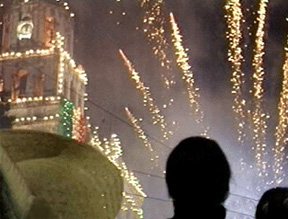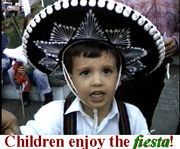El Grito—Mexican
Independence Day!
 By
Mary Swift-Swan
By
Mary Swift-Swan
Day, September 15th
El Grito is the cry for independence, “Mexicanos, Viva Mexico!”,
first given by respected Catholic priest Miguel Hidalgo y Costilla
in Dolores, Guanajuato, in the early hours of September 16, 1810. He
exhorted his Indian and mestizo* congregation to start the
Independence movement to throw off the shackles of Spanish rule. The
surprised congregation, armed with axes, clubs, and machetes and 300
years of pent up hatred for the cruel and oppressive rule of the
Spanish, came in answer to Hidalgo’s call, beginning the long and
bloody struggle.
When the Indians under Aztec rule joined forces
with Spanish conquerors to bring down the Aztec empire, their
population was 20 million. Within a century, their numbers were
dramatically reduced to only one million due to the disease brought
in by the Spanish and the brutal labor the Indians were forced to
endure as they buried the Venice-like Aztec capitol to build a new
city above it. In New Spain, class rules and privileges chafed below
the harsh leadership.
Groups of criollos (those of Spanish decent born
in Mexico) across Mexico plotted to overthrow the authority of
gachopines (those of Spanish decent born in Spain) who, because of
their Spanish heritage, had legal and social priority over the
criollos. When Joseph Bonaparte replaced King Ferdinand as the
leader of Spain, the criollos recognized a prime opportunity for
Mexican sovereignty. The nucleus of this movement was a group of
intellectuals in Querétaro led by the Corregidor of Querétaro, his
wife, and a group of army officers distinguished by the adventurous
Ignacio Allende.
The criollos plan for revolution did not
originally focus on the manpower of Mexicans. Rather, the criollos
sought to avoid military confrontation by convincing criollo army
officers to sever their allegiance to the gachopines. By claiming
loyalty to the defeated King Ferdinand, the criollos aimed to
establish Mexico as an independent nation within King Ferdinand’s
Spanish empire. It was hoped that gachopines who claimed authority
under Bonaparte’s rule would be driven out of Mexico.
Hidalgo had close ties with this group. At nearly
sixty years old, Hidalgo was loved and greatly respected by the
Mexican populace. Once the dean of the College of San Nicolas at
Valladolid in Michoacan (now Morelia), Hidalgo was a well-educated,
courageous humanitarian. He was sympathetic to the Indians, which
was unusual amongst Mexican clergymen. Against gachopine law,
Hidalgo taught Indians to plant olives, mulberries, and grapevines
and to manufacture pottery and leather. His actions angered the
Spanish viceroy who, as a punitive measure, cut down Hidalgo’s
Indian’s trees and vines claiming Hidalgo was a rebellious
influence.
 |
|
by Alfredo Zalce 1953 |
| The George
Washington of Mexico, Hidalgo y Costilla |
Word got out when a priest reportedly heard of the
criollos plans in confession from criollos officers who were
approached but did not want to join the movement. Three months
before their launch, gachopines found a house with a cache of
weapons and ammunition. They planned to arrest key criollos leaders
and Hidalgo. Allende rode through the night to warn Hidalgo of his
impending arrest. Near dawn on September 16, Hidalgo began the
revolution by ringing the church bell that called into action the
untapped manpower of Mexico. Together they marched.
When the Indian and Mestizo forces, led by Hidalgo and Allende,
reached the next village en route to Mexico City, they took a
picture of the Virgin of Guadalupe and made it their freedom banner.
The Virgin of Guadalupe was indigenous to Mexico and a woman of
color. Her image became the image of freedom for the revolutionary
forces as Hidalgo and Allende led troops toward Mexico City and the
expulsion of the gachopines.
Mexico erupted in flames under that banner of
freedom. When the army of Mexican independence fighters approached
Mexico City, they were 80,000 strong. Hidalgo was concerned for
massive loss of life on both sides and veered north. He was captured
in Texas, then part of Spanish rule, and executed on July 31st,
1811. Ten more years of strife ensued. By 1821, all the early
leaders of the uprising, Hidalgo, Ignacio Allende, and José María
Morelos, were dead. Agustín de Iturbide, a Creole soldier in the
service of the Spanish crown, had been charged with crushing the
freedom fighters.
 Agustín
changed sides. He allied himself to Vicente Guerrero and together
they announced the Plan de Iguala, which had three basic guarantees:
Roman Catholicism would be the country’s religion, all Mexican
citizens were to be equal, ending class discrimination, and there
was to be a constitutional monarchy. The Spaniards and Mexicans
accepted the plan, which was ratified by the Treaty of Córdoba,
finally giving Mexico victory and Independence.
Agustín
changed sides. He allied himself to Vicente Guerrero and together
they announced the Plan de Iguala, which had three basic guarantees:
Roman Catholicism would be the country’s religion, all Mexican
citizens were to be equal, ending class discrimination, and there
was to be a constitutional monarchy. The Spaniards and Mexicans
accepted the plan, which was ratified by the Treaty of Córdoba,
finally giving Mexico victory and Independence.
 El
Grito is celebrated on the evening of September 15 in Mexico City
and around the world. Why was September 15th versus the morning of
September 16th chosento celebrate Mexico’s Independence Day? The
answer is simple. President Porfírio Díaz began the tradition and
September 15th is his birthday. After a day of fiesta, between 11pm
and midnight the bell originally rung by Father Hidalgo, which now
hangs in the tower of the President’s office, rings to the cheers of
the packed crowd in Zolla Square. Following the ringing of the bell,
the names of the heroes of the revolution are called out and the
night sky is aglow with bursting fireworks.
El
Grito is celebrated on the evening of September 15 in Mexico City
and around the world. Why was September 15th versus the morning of
September 16th chosento celebrate Mexico’s Independence Day? The
answer is simple. President Porfírio Díaz began the tradition and
September 15th is his birthday. After a day of fiesta, between 11pm
and midnight the bell originally rung by Father Hidalgo, which now
hangs in the tower of the President’s office, rings to the cheers of
the packed crowd in Zolla Square. Following the ringing of the bell,
the names of the heroes of the revolution are called out and the
night sky is aglow with bursting fireworks.
* Mestizo is the term used to refer to Mexicans of mixed ancestry,
Spanish and Indian.
Some of the research sources used for this article include:
www.mexatua.com/page.cfm/banknoteheaven/products/Mexico/all/10,
http://www.mexonline.com/grito.htm, http://www.inside-mexico.com/featureindep.htm.